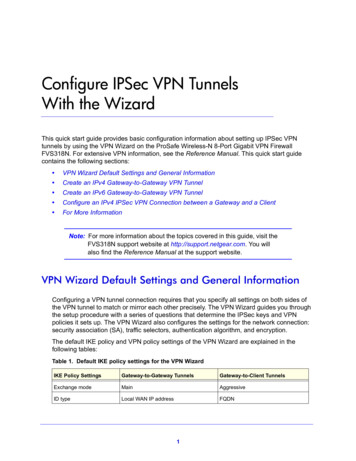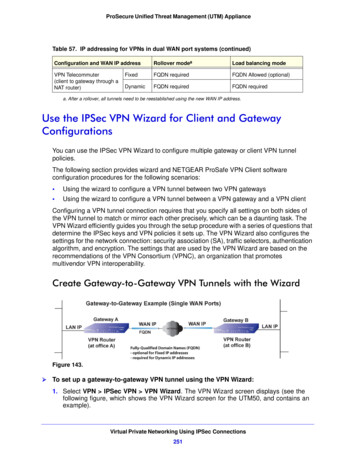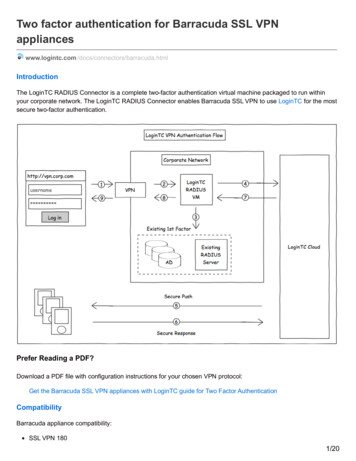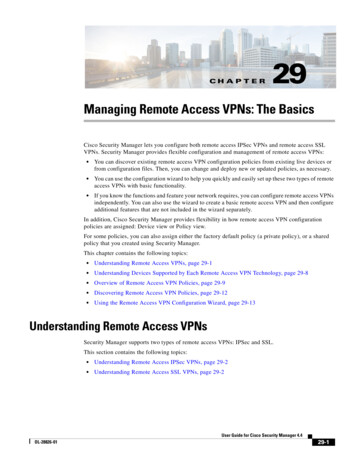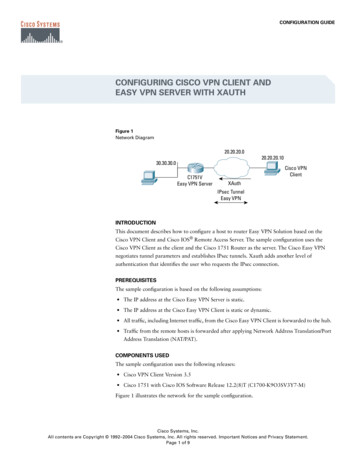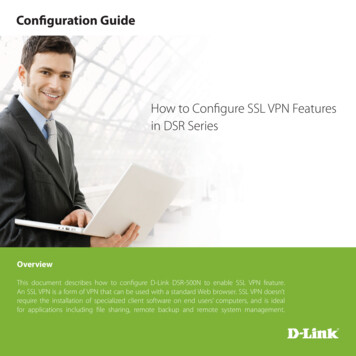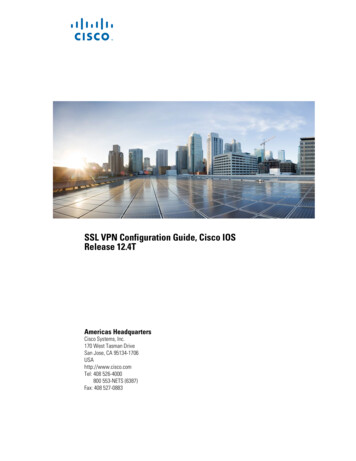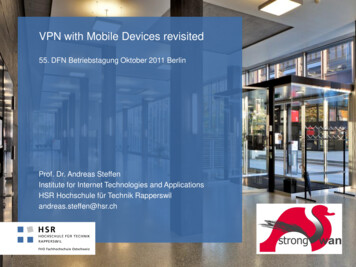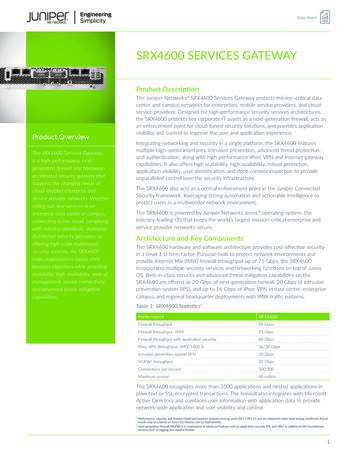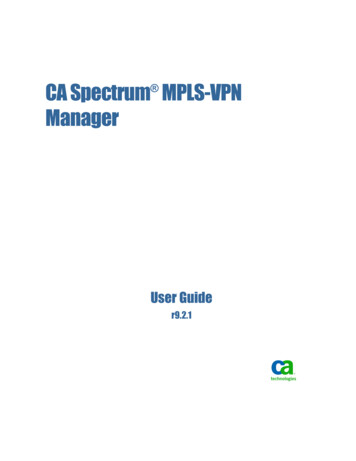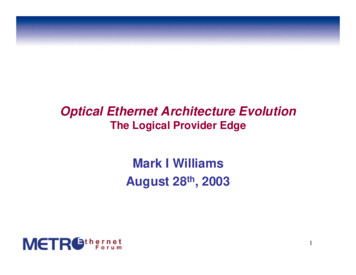
Transcription
What is a VPN?Paul Fergusonferguson@cisco.comGeoff Hustongih@telstra.netApril 1998Revision 1Abstract – The term “VPN,” or Virtual Private Network, has become almost as recklessly used in the networking industry as has"QoS" (Quality of Service) to describe a broad set of problems and "solutions," when the objectives themselves have not beenproperly articulated. This confusion has resulted in a situation where the popular trade press, industry pundits, and vendors andconsumers of networking technologies alike, generally use the term “VPN” as an offhand reference for a set of differenttechnologies. This paper attempts to provide a common sense definition of a VPN, and an overview of different approaches tobuilding them.Table of Contents1.2.3.4.5.6.7.8.A Common Sense Definition of Virtual Private NetworksVPN MotivationsTypes of VPN’sNon-IP VPN’sQuality of Service "The wonderful thing about virtual private networks is that its myriaddefinitions give every company a fair chance to claim that its existingproduct is actually a VPN. But no matter what definition you choose, thenetworking buzz-phrase doesn't make sense. The idea is to create a privatenetwork via tunneling and/or encryption over the public Internet. Sure,it's a lot cheaper than using your own frame relay connections, but itworks about as well as sticking cotton in your ears in Times Square andpretending nobody else is around." [1]1.A Common Sense Definition of Virtual Private NetworksAs Wired Magazine notes in the quotation above, the myriad definitions of a Virtual Private Network (VPN) are less than helpful in thisenvironment. Accordingly, it makes sense to begin this examination of VPN's to see if it is possible to provide a common sense definitionof a VPN. Perhaps the simplest method of attempting to arrive at a simple definition for VPN’s is to look at each word in the acronymindividually, and then subsequently tie each of them together in a simple, common sense, and meaningful fashion.Let’s start by examining the word “network.” This is perhaps the least difficult term for us to define and understand, since the commonlyaccepted definition is fairly uncontroversial and generally accepted throughout the industry. A network consists of any number of deviceswhich can communicate through some arbitrary method. Devices of this nature include computers, printers, routers, and so forth, andmay reside in geographically diverse locations. The methods in which they may communicate are numerous, since there are countless
What is a VPN?electronic signaling specifications, and data-link, transport, and application layer protocols. For the purposes of simplicity, let’s just agreethat a “network” is a collection of devices that can communicate in some fashion, and can successfully transmit and receive dataamongst themselves.The term “private” is fairly straightforward, and is intricately related to the concept of “virtualization” insofar as VPN’s are concerned, aswe’ll discuss in a moment. In the simplest of definitions, “private” means that communications between two (or more) devices is, in somefashion, secret – that the devices which are not participating in the “private” nature of communications are not privy to the communicatedcontent, and that they are indeed completely unaware of the private relationship altogether. Accordingly, data privacy and security (dataintegrity) are also important aspects of a VPN which need to taken into consideration when considering any particular VPNimplementation.Another means of expressing this definition of "private" is through its antonym, "public." A “public” facility is one which is openlyaccessible, and is managed within the terms and constraints of a common public resource, often via a public administrative entity. Bycontrast, a “private” facility is one where access is restricted to a defined set of entities, and third parties cannot gain access. Typically,the private resource is managed by the entities who have exclusive right of access. Examples of this type of private network can befound in any organizational network which is not connected to the Internet, or to any other external organizational network, for that matter.These networks are private due to the fact that there is no external connectivity, and thus no external network communications.Another important aspect of “privacy” in a VPN is through its technical definition, as describing the privacy of addressing and routingsystem, meaning that the addressing used within a VPN community of interest is separate and discrete from that of the underlying sharednetwork, and from that of other VPN communities. The same holds true for the routing system used within the VPN and that of theunderlying shared network. The routing and addressing scheme within a VPN should, for all intents and purposes, be self-contained, butthis degenerates into a philosophical discussion on the context of the term “VPN.” Also, it is worthwhile to examine the differencesbetween the “peer” and “overlay” models of constructing VPN’s – both of which are discussed in more detail in Section 3.1, “NetworkLayer VPN’s.”“Virtual” is a concept that is slightly more complicated. The New Hacker’s Dictionary (formerly known as the Jargon File) [2] definesvirtual as –virtual /adj./ [via the technical term “virtual memory”, prob. from the term “virtual image” in optics] 1. Common alternative to{logical}; often used to refer to the artificial objects (like addressable virtual memory larger than physical memory) simulated bya computer system as a convenient way to manage access to shared resources. 2. Simulated; performing the functions ofsomething that isn’t really there. An imaginative child’s doll may be a virtual playmate. Oppose {real}.Insofar as VPN’s are concerned, the definition in 2. above is perhaps the most appropriate comparison for virtual networks. The“virtualization” aspect is one that is similar to what we briefly described above as “private,” however, the scenario is slightly modified – theprivate communication is now conducted across a network infrastructure that is shared by more than a single organization. Thus, theprivate resource is actually constructed by using the foundation of a logical partitioning of some underlying common shared resource,rather than by using a foundation of discrete and dedicated physical circuits and communications services. Accordingly, the “private”network has no corresponding “private” physical communications system. Instead, the “private” network is a virtual creation which hasno physical counterpart. The virtual communications between two (or more) devices is due to the fact that the devices which are notparticipating in the virtual communications are not privy to the content of the data, and that they are also altogether unaware of theprivate relationship between the virtual peers. The shared network infrastructure could, for example, be the global Internet and thenumber of organizations or other users not participating in the virtual network may literally number into the thousands, hundreds ofthousands, or millions.A VPN can also said to be a discrete network [3] –discrete \dis*crete"\, a. [L. discretus, p. p. of discernere. See Discreet.] 1. Separate; distinct; disjunct.The discrete nature of VPN’s allow both privacy and virtualization. While VPN’s are not completely separate, per se, the distinction is thatthey operate in a discrete fashion across a shared infrastructure, providing exclusive communications environments which do not shareany points of interconnection.The combination of these terms produces VPN – a private network , where the privacy is introduced by some method of virtualization.A VPN could be built between two end-systems or between two organizations, between several end-systems within a single organizationor between multiple organizations across the global Internet, between individual applications, or any combination of the above.As an aside, it should be noted that there is really no such thing as a non-virtual network, when considering the underlying common publictransmission systems and other similar public infrastructure components as the base level of carriage of the network. What separates a VPNfrom a truly “private” network is whether the data transits a shared versus a non-shared infrastructure. For instance, an organization couldFerguson & HustonApril 1998, Revision 1Page 2
What is a VPN?lease private line circuits from various telecommunications providers and build a private network on the base of these private circuit leases,however the circuit switched network owned and operated by the telecommunications companies are actually circuits connected to theirDACS (Digital Access Cross-Connect Systems) network and subsequently their fiber optics infrastructure, and this infrastructure is shared byany number of organizations through the use of multiplexing technologies. Unless an organization is actually deploying private fiber andlayered transmission systems, any network is layered with “virtualized” connectivity services in this fashion.A VPN doesn’t necessarily mean communications isolation, but rather the controlled segmentation of communications for communities ofinterest across a shared infrastructure.The common and somewhat formal characterization of the VPN, and perhaps the most straightforward and strict definition, is:A VPN is a communications environment in which access is controlled to permit peer connectionsonly within a defined community of interest, and is constructed though some form of partitioning of acommon underlying communications medium, where this underlying communications mediumprovides services to the network on a non-exclusive basis.A simpler, more approximate, and much less formal description is:A VPN is private network constructed within a public network infrastructure, such as the globalInternet.It should also be noted that while VPN’s may be constructed to address any number of specific business needs or technical requirements,a comprehensive VPN solution provides support for dial-in access, multiple remote sites connected by leased lines (or other dedicatedmeans), the ability of the VPN service provider to “host” various services for the VPN customers (e.g., web hosting), and the ability tosupport not just intra-, but also inter-VPN connectivity, including connectivity to the global Internet.2.VPN MotivationsThere are several motivations for building VPN’s, but a common thread in each is that they all share the requirement to “virtualize” someportion of an organization’s communications – in other words, make some portion (or perhaps all) of the communications essentially“invisible” to external observers, while taking advantage of the efficiencies of a common communications infrastructure.The base motivation for VPN's lies in the economics of communications. Communications systems today typically exhibit thecharacteristic of a high fixed-cost component, and smaller variable cost components which vary with the transport capacity, or bandwidth,of the system. Within this economic environment, it is generally financially attractive to bundle a number of discrete communicationsservices onto a common high capacity communications platform, allowing the high fixed-cost components associated with the platform tobe amortized over a larger number of clients. Accordingly, a collection of virtual networks implemented on a single common physicalcommunications plant is cheaper to operate than the equivalent collection of smaller physically discrete communications plants, eachservicing a single network client.So, if aggregation of communications requirements leads to a more cost-effective communications infrastructure, why not pool all theseservices into a single public communications system? Why is there still the requirement to undertake some form of partitioning withinthis common system that results in these “virtual private” networks?In response to this, the second motivation for VPN’s is that of communications privacy, where the characteristics and integrity ofcommunications services within one closed environment is isolated from all other environments which share the common underlyingplant. The level of privacy depends greatly on the risk assessment performed by the subscriber organization – if the requirement forprivacy is low, then the simple abstraction of discretion and network obscurity may serve the purpose. However, if the requirement forprivacy is high, then there is a corresponding requirement for strong security of access and potentially strong security applied to datapassed over the common network.This paper can’t do justice to the concept of VPN’s without some historical perspective, so we need to take a quick look at why VPN’s arean evolving paradigm, and why they will continue to be an issue of confusion, contention, and disagreement. This is important, since youwill indeed discover that opinions on VPN solutions are quite varied, and everyone seems to be deeply religious on how they should beapproached.Historically, one of the precursors to the VPN was the Public Data Network (PDN), and the current familiar instance of the PDN is theglobal Internet. The Internet creates a ubiquitous connectivity paradigm, where the network permits any connected network entity toexchange data with any other connected entity. The parallels with the global Public Switched Telephone Network (PSTN) are, of course,all too obvious – where a similar paradigm of ubiquitous public access is the predominate characteristic of the network.Ferguson & HustonApril 1998, Revision 1Page 3
What is a VPN?The public data network has no inherent policy of traffic segregation, and any modification to this network policy of permitting ubiquitousconnectivity is the responsibility of the connecting entity to define and enforce. The network environment is constructed using a singleaddressing scheme and a common routing hierarchy, which allows the switching elements of the network to determine the location of allconnected entities. All of these connected entities also share access to a common infrastructure of circuits and switching.However, the model of ubiquity in the “Internet PDN” does not match all potential requirements, especially the need for data privacy. Fororganizations who wish to use this public network for private purposes within a closed set of participants (for example, connecting a set ofgeographically separated offices), the Internet is not always a palatable possibility. There are a number of factors behind this mismatch,including issues of quality of service (QoS), availability and reliability, use of public addressing schemes, use of public protocols, sitesecurity, and data privacy & integrity (the possibility of traffic interception). Additionally, a corporate network application may desire morestringent levels of performance management than is available within the public Internet, or indeed may wish to define a managementregime which differs from that of the underlying Internet PDN.It is worthwhile at this point to briefly examine the importance of Service Level Agreements (SLA’s) in regards to the deployment ofVPN’s. SLA’s are negotiated contracts between VPN providers and their subscribers, which contain the service criteria to which thesubscriber expects specific services to be delivered. The SLA is arguably the only binding tool at the subscriber’s disposal with which toensure that the VPN provider delivers the service(s) to the level and quality as agreed, and it is in the best interest of the subscribers tomonitor the criteria outlined in the SLA for compliance. However, Service Level Agreements present some challenging technical issuesboth for the provider and the subscriber. For the subscriber, the challenge is to devise and operate service measurement tools which canprovide a reasonable indication as to what extent the SLA is being honored by the provider. Also, it should be noted that a subscribermay use a SLA to bind one or more providers to a contractual service level, but if the subscriber’s VPN spans multiple provider'sdomains, the SLA must also encompass the issue of provider interconnection and the end-to-end service performance. For the provider,the challenge lies in honoring multiple SLA’s from a number of service providers. In the case of an Internet PDN provider, the commonmode of best effort service levels, is not conducive to meeting SLA’s, given the unpredictable nature of the host’s resource allocationmechanisms. In such environments, the provider either has to ensure that the network is very generously engineered in terms of the ratioof subscriber access capacity to internal switching capacity, or the provider can deploy service differentiation structures to ensure thatminimum resource levels are allocated to each SLA subscriber. It must be noted that the former course of action does tend to reduce thebenefit of aggregation of traffic, which in turn does have an ultimate cost implication, while the latter course of action does haveimplications in terms of operational management complexity and scalability of the network.The alternative to using the Internet as a VPN today is to lease circuits, or similar dedicated communications services, from the publicnetwork operators (the local telephone company in most cases), and create a completely private network. It is a layering conventionwhich allows us to label this as ”completely private,” as these dedicated communications services are (at the lower layers of the protocolstack) again instances of virtual private communications systems constructed atop a common transmission bearer system. Of course,this is not without precedent, and it must be noted that the majority of the early efforts in data networking, and many of the current datanetworking architectures, do not assume a deployment model of ubiquitous public access.As an aside, it should be noted that this is quite odd, when you consider that the inherent value of an architecture where ubiquitous publicaccess over a chaotic collection of closed private networks had been conclusively demonstrated in the telephony marketplace since the start ofthe 20th century. While the data communications industry appears to be moving at a considerable technological pace, the level of experientiallearning, and consequent level of true progress as distinct from simple motion, still leaves much to be desired!Instead of a public infrastructure deployment, the deployment model used has been that of a closed (or private) network environmentwhere the infrastructure, addressing scheme, management, and services were dedicated to a closed set of subscribers. This modelmatched that of a closed corporate environment, where the network was dedicated to serve a single corporate entity as the sole client.This precursor to the VPN can be called the private data network, and was physically constructed using dedicated local office wiring anddedicated leased circuits (or private virtual circuits from an underlying switching fabric such as X.25) to connect geographically diversesites.However, this alternative does have an associated cost, in that the client now has to manage the network and all it’s associated elements,invest capital in network switching infrastructure, hire trained staff, and assume complete responsibility for the provisioning and on-goingmaintenance of the network service. Such a dedicated use of transport services, equipment, and staff is often difficult to justify for manysmall-to-medium sized organizations, and while the functionality of a private network system is required, the expressed desire is toreduce the cost of the service through the use of shared transport services, equipment, and management. There are a number ofscenarios which can address this need, ranging from outsourcing the management of the switching elements of the network (managednetwork services), to outsourcing the capital equipment components (leased network services), to outsourcing of the management,equipment, and transport elements to a service provider altogether.Ferguson & HustonApril 1998, Revision 1Page 4
What is a VPN?In the simple example illustrated in [Figure 1], Network “A” sites have established a VPN (depicted by the red lines) across the serviceprovider’s backbone network, where Network “B” is completely unaware of it’s existence. Both Network “A” and Network “B” canharmoniously coexist on the same backbone infrastructure. 63%%63%% 63%%6363%% %%636H UYLFH 3URYLGHU%D FNERQH 5RXWHU 1HWZRUN %%1HWZRUN %93 1 Figure 1This is, in fact, the most common type of VPN – one in which there are geographically diverse subnetworks which belong to a commonadministrative domain, interconnected by a shared infrastructure outside of their administrative control (such as the global Internet or asingle service provider backbone). The principle motivation in establishing a VPN of this type is that perhaps the majority ofcommunications between devices within the VPN community may be sensitive in nature (again, a decision on the level of privacy requiredrests solely on a risk analysis performed by the administrators of the VPN), yet the total value of the communications system does notjustify the investment in a fully private communications system which uses discrete transmission elements.On a related note, the level of privacy a VPN may enjoy depends greatly on the technology used to construct the VPN. For example, ifthe communications between each VPN subnetwork (or between each VPN host) is securely encrypted as it transits the commoncommunications infrastructure, then it can said that the privacy aspect of the VPN is relatively high.In fact, the granularity of a VPN implementation can be broken down further to a single end-to-end, one-to-one connectivity scenario.Examples of these types of one-to-one VPN’s are single dial-up users establishing a VPN connection to a secure application, such as anonline banking service, or a single user establishing a secure, encrypted session between a desktop and server application, such as apurchasing transaction conducted on the World Wide Web. This is type of one-to-one VPN is becoming more and more prevalent assecure electronic commerce applications become more mature and further deployed in the Internet.It is interesting to note that the concept of virtualization in networking has also been considered in regard to deploying both research andproduction services on a common infrastructure. The challenge in the research and education community is one where there is a need tosatisfy both network research and production requirements. VPN’s have also been considered as a method to segregate traffic in anetwork such that research and production traffic behave as “ships in the night,” oblivious to one another’s existence, to the point thatmajor events (e.g. major failures, instability) within one community of interest are completely transparent the other. This concept isfurther documented in MORPHnet [4].It should also be noted that VPN’s may be constructed to span more than one host communications network, so that the “state” of theVPN may be supported on one or more VPN provider networks. This is perhaps at its most robust when all the providers explicitlyFerguson & HustonApril 1998, Revision 1Page 5
What is a VPN?support the resultant distributed VPN environment, but other solutions which do not necessarily involve knowledge of the overlay VPN areoccasionally deployed with mixed results.3.Types of VPN’sThe confusion factor comes into play in the most basic discussions regarding VPN’s. This is principally due to the fact that there areactually several different types of VPN’s, and depending on the functional requirements, several different methods of constructing eachtype of VPN is available. The process of selection should include consideration of what problem is being solved, risk analysis of thesecurity provided by a particular implementation, issues of scale in growing the size of the VPN, and the complexity involved in bothimplementing the VPN, as well as ongoing maintenance and troubleshooting.To simplify the description of the different types of VPN’s, they have been principally broken down in this paper into categories whichreside in the different layers of the TCP/IP protocol suite [Figure 2].7&3 ,33URWRFRO 0RGHO S SOSOLL FDWLRQ7 U D QVQVSS RUW1 HWHWZZ RURUNN/ L Q N / D \HUFigure 23.1Network Layer VPN’sThe network layer in the TCP/IP protocol suite consists of the IP routing system – how reachability information is conveyed from onepoint in the network to another. There are a few methods to construct VPN’s within the network layer – each are examined below. A briefoverview of non-IP VPN’s is provided in Section 4.0.It is perhaps noteworthy at this point to provide a brief overview of the differences in the “peer” and “overlay” VPN models. Simply put,the “peer” VPN model is one in which the network layer forwarding path computation is done on a hop-by-hop basis, where each node inthe intermediate data transit path is a peer with a next-hop node. Traditional routed networks are examples of “peer” models, where eachrouter in the network path is a peer with their next-hop adjacencies. Alternatively, the “overlay” VPN model is one in which the networklayer forwarding path is not done on a hop-by-hop basis, but rather, the intermediate link layer network is used as a “cut-through” toanother edge node on the other side of a large cloud. Examples of “overlay” VPN models are ATM, Frame Relay, and tunnelingimplementations.Having drawn these simple distinctions between the peer and overlay models, it should be noted that the overlay model introduces someserious scaling concerns in cases where large numbers of egress peers are required. This is due to the fact that the number ofadjacencies increase in direct relationship with the number of peers – the amount of computational and performance overhead required tomaintain routing state, adjacency information, and other detailed packet forwarding and routing information for each peer becomes aliability in very large networks. If each egress node in a cut-through network become peers, in an effort to make all egress nodes one“Layer 3” hop away from one another, this limits the scalability of the VPN overlay model quite remarkably.For example, as the simple diagram [Figure 3] illustrates, the routers surrounding the interior switched infrastructure represent egresspeers, since the switches in the core interior could be configured such that all egress nodes are one “Layer 3” hop away from oneanother, creating what is commonly known as a “cut-through.” This is the foundation of an overlay VPN model. Alternatively, if theFerguson & HustonApril 1998, Revision 1Page 6
What is a VPN?switches in the interior were replaced with routers, then the routers positioned at the edge of the cloud now become peers with their nexthop router nodes, not other egress nodes. This is the foundation of the peer VPN model.Router (Egress Point)Switch (Cut-Through)Figure 33.1.1Controlled Route Leaking“Controlled route leaking” (or route filtering) is a method which could also be called “privacy through obscurity,” since it consists of nothingmore than controlling route propagation to the point that only certain networks receive routes for other networks which are within theirown community of interest. This model can be considered a “peer” model, since a router within a VPN site establishes a routingrelationship with a router within the VPN provider's network, instead of an edge-to-edge routing peering relationship with routers in othersites of that VPN. While the common underlying Internet generally carries the routes for all networks connected to it, this architectureassumes that only a subset of such networks form a VPN. The routes associated with this set of networks are filtered such that they arenot announced to any other set of connected networks, and that all other non-VPN routes are not announced to the networks of the VPN.For example, in [Figure 1] above, if the service provider (SP) routers "leaked" routing information received from one site in Network "A" toonly other sites in Network "A", then sites not in Network "A" (e.g., sites in Network "B") would have no explicit knowledge of any othernetworks which where attached to the service provider's infrastructure [Figure 4]. Given this lack of explicit knowledge of reachability toany location other than other members of the same VPN, privacy of services is implemented by the inability of any of the VPN hosts torespond to packets which contain source addresses from outside the VPN community of interest.Ferguson & HustonApril 1998, Revision 1Page 7
What is a VPN? 5 R X WH ) LOW HU WR5 R X WH ) LOW HU WR 3 H U P LW 5 R X WH U ) L OWH U WR3 H U P LW 3 H U P LW 63%%63%% 63%%6363%%5 R X WH ) LOW HU WR 3 H U P LW 636HUYLFH 3URYLGHU%DFNERQH 5 RXWHU 1HWZ RUN %% 1HWZ RUN %%%931 Figure 4This use of partial routing information is prone to many forms of misconfiguration. One potential problem with route leaking is that it isextremely difficult, if not impossible, to prohibit the subscriber networks from pointing default to the upstream next-hop router for trafficdestined for networks outside of their community of interest. From within the VPN subscriber’s context, this may be a reasonable action,in that “default” for the VPN is reachability to all other members of the same VPN, and pointing a default route to the local egress path is,within a local context, a reasonable move. Thus, it is no surprise that this is a common occurrence in VPN’s where the customerconfigures and manages the CPE (customer premise equipment) routers. If the service provider manages the configuration of th
private relationship between the virtual peers. The shared network infrastructure could, for example, be the global Internet and the number of organizations or other users not participating in the virtual network may literally number into the thousands, hundreds of thousands, or millions. A VPN can also said to be a discrete network [3] -
